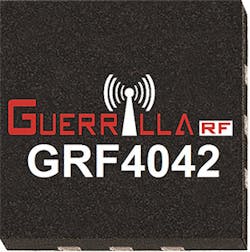This file type includes high-resolution graphics and schematics when applicable.
High-frequency devices and integrated circuits (ICs) are hitting the market at a rapid-fire pace, reflecting how suppliers continue to push the envelope through technological innovation. Various device technologies are making an impact in many target applications, including one exciting new possibility: RF solid-state cooking.
Gallium-nitride (GaN) technology is undoubtedly all the rage today. But other semiconductor technologies, such as laterally diffused metal-oxide semiconductor (LDMOS), are still alive and well, judging by several recently unveiled high-power LDMOS devices. In addition, the industry has seen the arrival of myriad new amplifier products—both high-power and low-noise varieties—to satisfy today’s diverse requirements.
High-Power LDMOS Devices
Despite the attention being thrown at GaN technology, now that it’s being used to enable several different applications, other semiconductor technologies still play an important role. LDMOS technology, for example, remains vital. In fact, a handful of new LDMOS-based products recently hit the marketplace.
LDMOS devices are a staple product of NXP Semiconductors. The company’s high-power LDMOS-based products can enable a range of applications, such as cellular infrastructure, radar, and mobile radio.
Two new LDMOS-based products developed by NXP are the A2I25H060N and A2T26H165-24S. The A2I25H060N is an asymmetrical Doherty power amplifier (PA) that spans 2300 to 2690 MHz. It is suitable for all typical cellular base-station modulation formats. The A2T26H165-24S is a 32-W power transistor that covers 2496 to 2690 MHz. Like the A2I25H060N, the A2T26H165-24S will find homes in cellular base stations.
For its part, Ampleon expanded its line of LDMOS-based products by releasing a portfolio of new RF power transistors. The new BLP05H6xxxXR series aims for markets like TV broadcasting, as well as industrial, scientific, and medical (ISM) RF power generators. The transistors, which span a frequency range from HF to 600 MHz, provide anywhere from 35 to 700 W of continuous-wave (CW) power. Furthermore, the transistors all come in an SOT-1223 package.
LDMOS technology also is the driving force behind RF solid-state cooking (Fig. 1). Both NXP and Ampleon, who are at the forefront of this emerging niche, believe that solid-state technology can potentially replace the venerable magnetron-based microwave ovens.
“Using RF power transistors for solid-state cooking applications is high on the list of exciting new application areas for RF energy usage,” says Gerrit Huisman, marketing director at Ampleon. “Magnetrons have had a long life within our microwave ovens. We have all experienced the hot and cold spots they can create in our food. Thanks to recent technology developments, RF power transistors are now viewed as reliable and ideal candidates for microwave cooking applications.”
Huisman adds, “There is no doubt that the accurate power control of a solid-state device greatly helps to provide more control and stability in the cooking cycle. An oven’s operation can now set the cooking profile depending on what it finds in the oven, instead of blindly working to a user set-time.
“The power output, frequency, and appliance power efficiency will vary depending on, for example, whether a bag of popcorn is being cooked or a frozen chicken,” he says. “Cooking times are reduced by about 30% and taste is improved. Most importantly, homogeneously cooking is achieved. This means that food will not be over- or under-cooked. With added modern sensor technology, it is possible to constantly monitor, adapt, and optimize the cooking process.”
Higher Power Devices at Higher Frequencies
Suppliers are meeting the demand for high-power devices at higher frequencies, such as Ka-band, which is now commonly used for satellite-communications (satcom). GaN technology also has extended into this frequency range.
New Ka-band PAs have recently been introduced to the marketplace. For example, Qorvo unveiled its TGA2636-SM, a Ka-band, 3-W GaN PA for commercial very-small-aperture-terminal (VSAT) satellite ground terminals. The TGA2636-SM, housed in a 5- × 5-mm, surface-mount-technology (SMT) package, provides 25 dB of linear gain while achieving 30% power-added efficiency (PAE). The PA is fabricated using Qorvo's 0.15-μm gallium-nitride on silicon-carbide (GaN on SiC) process. The company says this process delivers three times more power density than previous-generation gallium-arsenide (GaAs) pseudomorphic high-electron-mobility-transistor (pHEMT) solutions.
MACOM entered the fray by unleashing its MAAP-011246 and MAAP-011139 Ka-band PAs. Both devices are offered in 5- × 5-mm, SMT packages. The MAAP-011246, which covers 27.5 to 31.5 GHz, provides 2 W of output power. The MAAP-011139 is a 4-W PA that spans 28.5 to 31.0 GHz. Both PAs are well-suited for next-generation Ka-Band VSAT systems.
Low-Noise Amplifiers in the News
Though high-power devices seem to be dominating, several new low-noise amplifiers (LNAs) have opened some eyes, too. A common theme among the latest LNAs is that external components are minimized significantly, thus turning them into convenient, low-cost solutions.
Sparking interest on this front is Custom MMIC’s new CMD223 LNA, which spans 9 to 18 GHz. It’s targeted at electronic-warfare (EW) and communication systems that demand small size and low power consumption. At 13.5 GHz, the CMD223 delivers more than 22 dB of gainand achieves a 1.5-dB noise figure.
Two new LNAs from Skyworks, the SKY65605-21 and SKY65611-11, are fabricated using advanced silicon-germanium (SiGe) BiCMOS technology. Both LNAs operate from 1.559 to 1.606 GHz, and are intended for Global Navigation Satellite Systems (GLONASS), BeiDou, Global Positioning System (GPS), and Galileo receiver applications. The SKY65606-21, for example, achieves a typical gain of 19 dB along with a noise figure of 0.6 dB.
Guerrilla RF recently launched its GRF4042 LNA (Fig. 2). The device is well-suited for small-cell and cellular booster applications in the 700- to 3800-MHz frequency range. Offered in a 2- × 2-mm SMT package, the GRF4042 achieves a sub-1-dB noise figure.
Although not every new product could be mentioned in this report, it can be clearly seen that manufacturers are supporting a wide range of applications using several different technologies. Such innovation is never more apparent than in the strides made with RF solid-state cooking. It will certainly be interesting to watch what devices and products will make their impact on the industry in the coming year.



